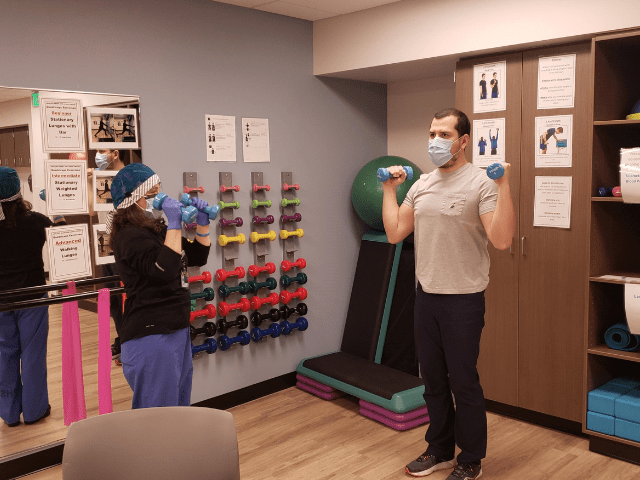Patient Stories
A heart attack? I'm only 39! A true patient story.
March 08, 2021
Home > About > News & Media > Story Center
Jorge Rosales was walking home with his dog when he suddenly had a hard time breathing and felt numb on his left side. His body also felt heavy and his heart was fluttering.
Jorge, 39-years-old at the time, was having a heart attack—a visit to the emergency room at Legacy Meridian Park Medical Center would confirm this. Stents were put in and rehabilitation followed. But Jorge never completed the program.
“I’m an insurance adjuster, and my job is stressful,” Jorge says. “I would have had to take time off from work. It was just too much so I didn’t do it.”
Soon, Jorge had a second heart attack. He collapsed at home after a bike ride with his partner, a doctor. At the hospital, two more blockages were discovered.
“This time, I took it seriously,” Jorge says. He took three months off from work to focus on three weekly visits to cardiac rehabilitation at Legacy Emanuel Medical Center.
Jorge is one of an increasing number of people experiencing heart attacks before the age of 40. The number of Hispanics in this group has risen in particular. Data from the Center for Disease Control and Prevention (CDC) lists heart disease as the leading cause of death for Hispanic men and second for Hispanic women. Jorge is a Latino from El Salvador.
Jorge, now 40, has advice for anyone who does not take this health threat seriously. “I thought I was too young and that my heart was okay.”
But Jorge had underlying conditions that he did not take seriously as well as an unhealthy diet. High cholesterol and diabetes, for example, ran in his family. And he ate a lot of meat, cheese, and foods with a lot of fat, especially cheese pupusas, a favorite of El Salvadoran cuisine. Plus, he did not exercise regularly.
“I was a little heavy, and I put on more weight prior to my second heart attack,” he says.
Dr. David Peizner, a cardiologist at Legacy Medical Group, says the combination of bad diet and lack of exercise makes cardiovascular disease more common.
“These higher risk factors can result in a greater incidence of cardiovascular disease at a younger age,” says Dr. Peizner.
These days, Jorge eats mostly vegetables, whole grains, fruit, chicken, and fish. He stopped drinking alcohol and eating red meat, white bread, and processed food. He also exercises regularly.
“After I got home from the hospital last time, I got rid of all the fatty foods in the refrigerator.”
Jorge’s goal is to get back to a balanced weight and continue all of his good habits for a long time.
“I feel good with the changes I have made,” he says. “I don’t think about having another heart attack. I’m a very positive person. I want to live.”
Jorge, 39-years-old at the time, was having a heart attack—a visit to the emergency room at Legacy Meridian Park Medical Center would confirm this. Stents were put in and rehabilitation followed. But Jorge never completed the program.
“I’m an insurance adjuster, and my job is stressful,” Jorge says. “I would have had to take time off from work. It was just too much so I didn’t do it.”
Soon, Jorge had a second heart attack. He collapsed at home after a bike ride with his partner, a doctor. At the hospital, two more blockages were discovered.
“This time, I took it seriously,” Jorge says. He took three months off from work to focus on three weekly visits to cardiac rehabilitation at Legacy Emanuel Medical Center.
Jorge is one of an increasing number of people experiencing heart attacks before the age of 40. The number of Hispanics in this group has risen in particular. Data from the Center for Disease Control and Prevention (CDC) lists heart disease as the leading cause of death for Hispanic men and second for Hispanic women. Jorge is a Latino from El Salvador.
Jorge, now 40, has advice for anyone who does not take this health threat seriously. “I thought I was too young and that my heart was okay.”
But Jorge had underlying conditions that he did not take seriously as well as an unhealthy diet. High cholesterol and diabetes, for example, ran in his family. And he ate a lot of meat, cheese, and foods with a lot of fat, especially cheese pupusas, a favorite of El Salvadoran cuisine. Plus, he did not exercise regularly.
“I was a little heavy, and I put on more weight prior to my second heart attack,” he says.
Dr. David Peizner, a cardiologist at Legacy Medical Group, says the combination of bad diet and lack of exercise makes cardiovascular disease more common.
“These higher risk factors can result in a greater incidence of cardiovascular disease at a younger age,” says Dr. Peizner.
These days, Jorge eats mostly vegetables, whole grains, fruit, chicken, and fish. He stopped drinking alcohol and eating red meat, white bread, and processed food. He also exercises regularly.
“After I got home from the hospital last time, I got rid of all the fatty foods in the refrigerator.”
Jorge’s goal is to get back to a balanced weight and continue all of his good habits for a long time.
“I feel good with the changes I have made,” he says. “I don’t think about having another heart attack. I’m a very positive person. I want to live.”


